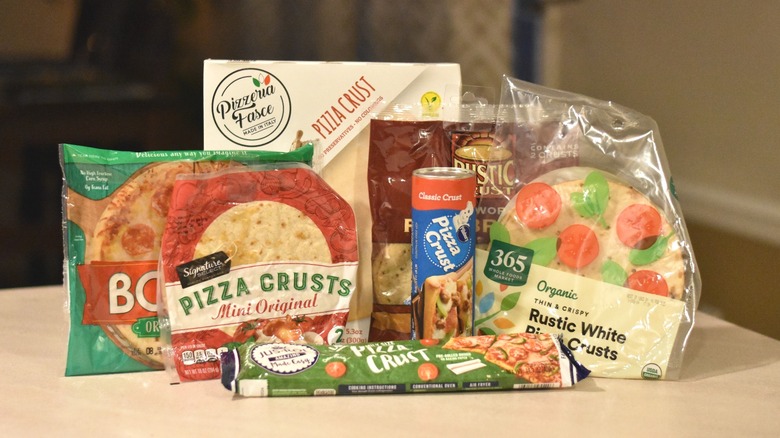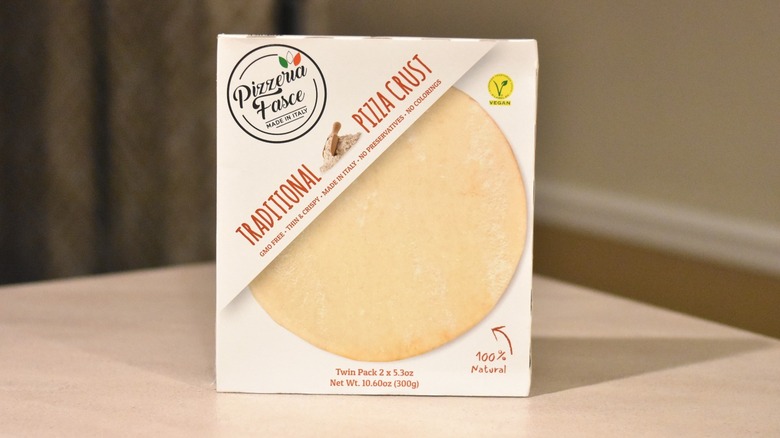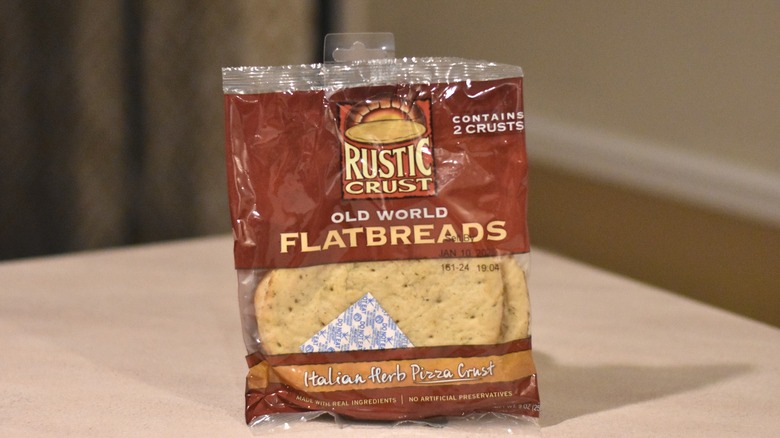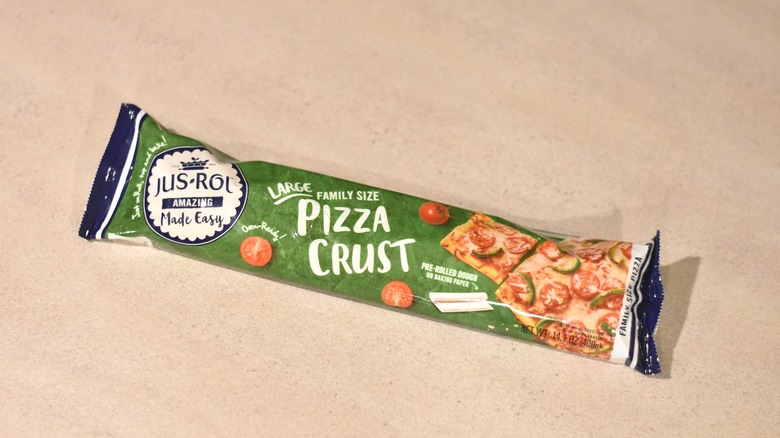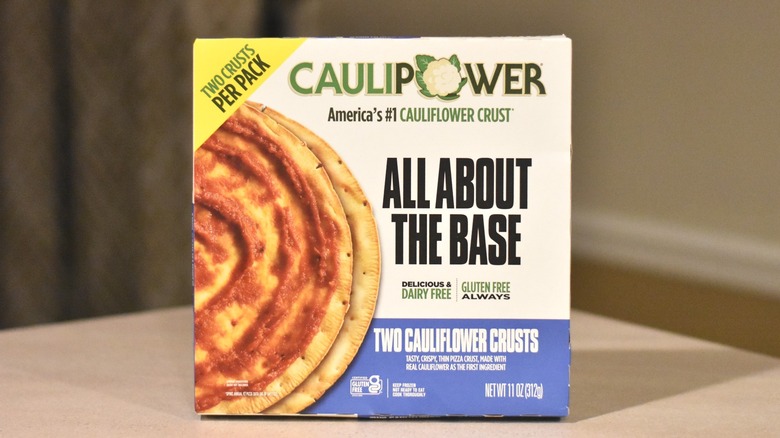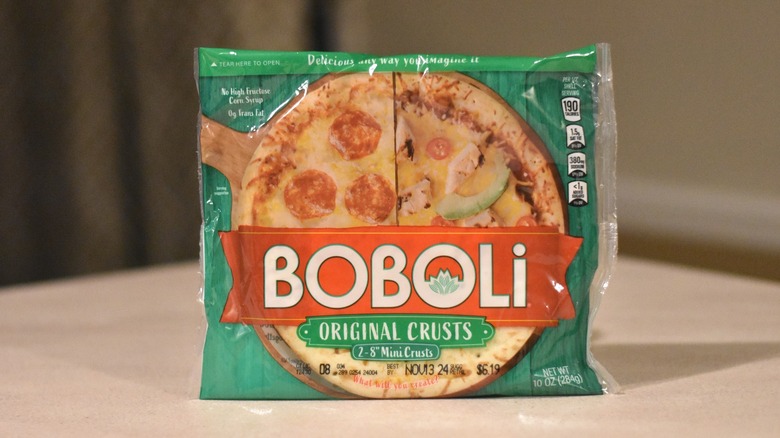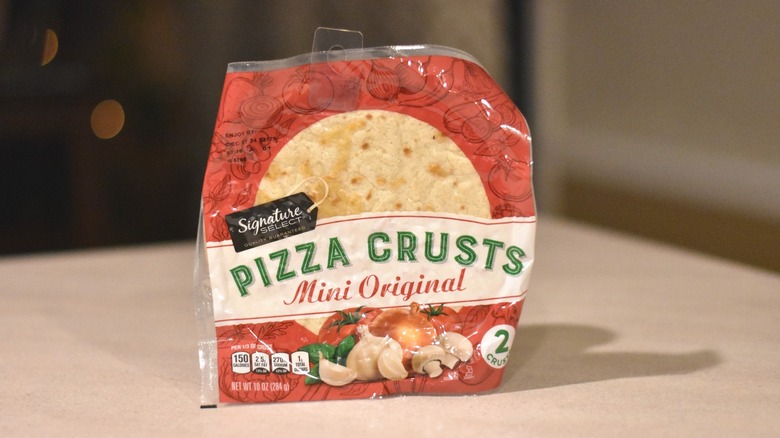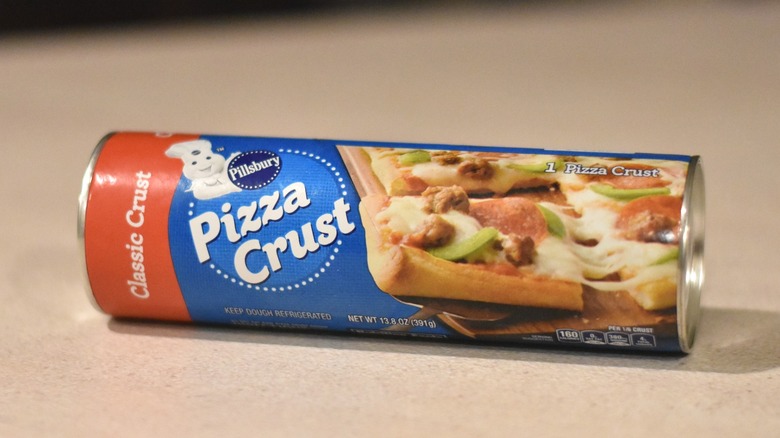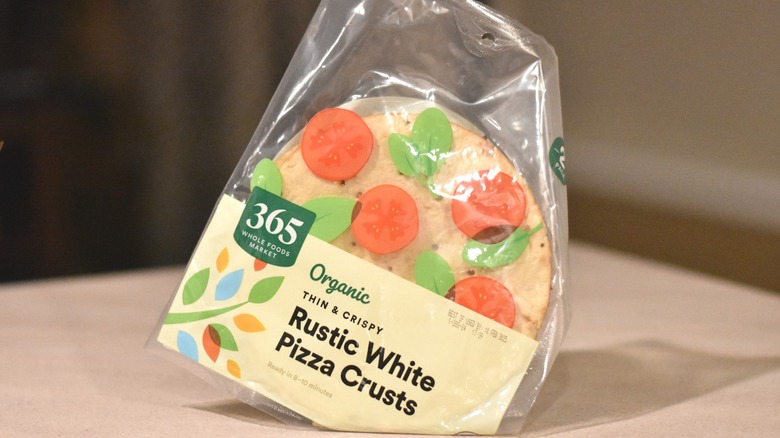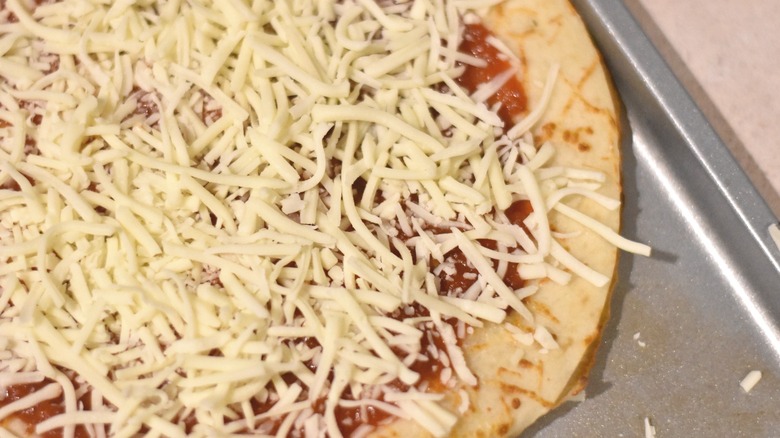Store-Bought Pizza Crusts, Ranked Worst To Best
You can enjoy DIY pizza night at home without the hassle of laboring over homemade crust thanks to store-bought options. Here are the choices you're likely to see at the grocery store, ranked from worst to best according to my testing. I whipped up a few personal pizzas with our favorite sauce and toppings, plus a generous helping of cheese.
There are quite a few pizza dough options at the store, but for this list, I stuck with crusts that were ready to use. Some came pre-baked and all you had to do was add toppings, which cut down on prep time significantly. Others required some rolling and baking but were already prepared for use. I tested each one, making both cheese and pepperoni pizzas. When trying the pizzas, I sampled for taste and texture. Some were thick crust options while others had more thin, crispy qualities. In addition to the actual dining experience, I considered cost, since making pizza at home can be a budget-friendly alternative to delivery or takeout. Prices may vary based on location.
8. Pizzeria Fasce pizza crust
Pizzeria Fasce is straight from Italy and made with high-quality, organic ingredients. It is free of preservatives and artificial coloring. I tried the classic version, which came in a set of two, but the brand also makes vegetable options that look interesting. You can get pizza crust made from cauliflower, beetroot, butternut squash, black carrot, broccoli, spinach, or basil. But these can be hard to track down and ordering them requires extra steps and time, since they are imported from Italy. I only saw the classic variety in U.S.-based stores and even that was not carried by many retailers.
I wanted to like this pizza crust, which I hoped would have an authentic taste just like pizzas we'd enjoyed in Naples. But it tasted like some of the worst frozen pizzas out there, with a flavorless dense crust that somehow managed to make even delicious sauce taste less intense. It was crispy all the way through and difficult to chew. I made a standard cheese pizza but adding extra flavorful ingredients would make this even harder to eat.
7. Rustic Crust woodfired pizza crust
Another good choice if you like a medium-density pizza crust is from Rustic Crust. The Italian herb version adds extra flavor but you can also opt for traditional or sourdough. They are a little bit pricey but worth it if you like the distinct taste. It was thick enough to hold up to a generous amount of toppings but not so stiff that I couldn't fold it over to make eating a slice easier. This is the mark of a good pizza crust in my book.
If you're able to find it, go with the Italian herb variety of this crust. I only saw it at one store, but I'd go out of our way to find it again. The Italian herb option works well to add some extra flavor that isn't overpowering, especially if you add some spicy pepperoni to your pizza. I tried it with a standard cheese pizza and were happy with the extra herbiness. It would be especially delicious with a white pizza sauce, which is what I plan to try next.
6. Jus-Rol pre-rolled pizza crust dough
Jus-Rol pizza dough is ready to go right out of the package. This option is budget-friendly at less than $4 for a large family size and easy to top with your favorites. This is one of the few options that comes in a rectangle, which works well if you have a baking sheet rather than a traditional circular pizza pan. After baking, it had a medium thickness and is soft in the middle while still achieving a crispy edge. The taste isn't anything exceptional, but it works well with flavorful sauce and toppings.
Because it's dough rather than already baked, you can also transform it into creative pizza-inspired snacks. In addition to its size and shape, the versatility of this option is what sets it apart from others on the list. It is rolled up with a piece of parchment paper to keep it from sticking. The crust needs to be unrolled onto the tray before baking, which can cause cracking, especially if it's been frozen. But these small wrinkles are easy to smooth out with your hand and a bit of water before you start baking.
5. Caulipower frozen cauliflower pizza crust
For those who are gluten-free, cauliflower pizza crust might be the best option. Caulipower is one of the best-known brands, although it can still be tricky to find at most grocery stores. The brand has a nice prepared frozen pizza selection, but finding the crust alone can be a bit harder. This crust is made with cauliflower rather than traditional flour and works for those who want or need to avoid gluten. It's also free of artificial colors, flavors, and preservatives, so consider trying it if you have other food sensitivities, as well.
The taste and texture of Caulipower frozen pizza crust was surprisingly similar to standard crust. It crisps up much better than cauliflower crusts that I've made at home and has a slight herb flavor, as well. The big downside for this option is the price. It costs more than $10 for two medium-sized crusts and you'd likely need to prepare both for a family meal. Unless you have a strong desire or need to go gluten-free, we recommend sticking with something a bit more budget-friendly and easier to find.
4. Boboli
Boboli is one of the top brands when it comes to pre-baked pizza crust that you can customize at home. It's definitely the easiest to find and carried in most major grocery store chains. These come in mini and full sizes, which are sold in packages of two or one. All you have to do to enjoy is add your favorite toppings and enjoy.
These tasted as expected without a strong flavor, which was nice since I generally prefer the pizza sauce and toppings to be the stars of my pizza. The crust worked as a nice base, even for pizzas that were loaded up. It had crispy edges after baking and was just the right amount of flaky. The crust was a medium-height compared to other options that we tried, so don't expect a super thin rust. It was substantial enough to have some give on the inside while still maintaining a crisp exterior base that didn't get soggy. These were also a bit on the expensive side at just over $6 for a two-pack of 8-inch pizza crusts, especially when you consider that there are plenty of store brands that are available for a few dollars less.
3. Signature Select pizza crust
Choose from original, thin crust, or mini from Safeway's store brand, Signature Select. At $4 for a two-pack of mini crusts, they're budget-friendly normally but an even better deal if you use your store loyalty card. I tried the original recipe crust in the personal pizza size. They came pre-made and all we had to do was add sauce and toppings.
I liked the taste of these pizza crusts, but the texture was a little bit too hefty for our liking. The closest comparison was Boboli and these had the name brand beat just because of the better price. They had a doughy center when we baked them for the recommended amount of time, although I suspected that leaving them in the oven would result in a charred outside so it's best to stick to the eight to 10 minute time. If you're making a pizza with a lot of toppings and need a crust that won't bend or fold, this is a great choice. For a simple cheese or pepperoni pizza, it felt like a bit too much. The thin crust is a better option if you want a crust that works with simple sauce and cheese, although it is super crispy.
2. Pillsbury classic pizza dough
Sold by the tube, Pillsbury is a good option if you want to experiment with different uses for pizza crust. You can make a calzone, mini pizzas, or a traditional pan pizza. They're found in the refrigerator section, typically near the cookie dough and other pre-made items. This crust comes in a pressurized tube and requires you to crack open the tube, then lay out the dough on your baking sheet. The crust has a slight buttery taste and is flaky, although the edges don't get as crispy as some other brands. But if you like a softer crust, this is the one for you.
It does require baking before you're ready to put the toppings on. This adds an extra step as well as time, but it wasn't a deal-breaker for me. Given the versatility of this pizza crust, I actually prefer it over pre-made crusts if I'm not sure when or how I'm going to use it. You can use it as a base for pizza muffins by cutting it into smaller pieces and molding it to the bottom of a muffin in. The unopened canister keeps in the refrigerator for a few weeks and is a nice ingredient to keep on hand.
1. 365 pizza crust
The Whole Foods store brand, 365, makes pizza crust in original, whole wheat, and thin and crispy styles with organic ingredients. All you have to do is add toppings and pop it in the oven for eight to 10 minutes. I recommend checking your pizza starting at six minutes to keep the crust from getting to done. It has holes in it to let the air circulate and get it crispy, but it can easily get burnt if you're not closely monitoring it. It's around $5 for a two-pack of crusts, but you can find extra savings occasionally if you are an Amazon Prime member by using your in-store discount code.
I tried the thin and crispy style because it was the only one that our local Whole Foods had in stock. The selection at the store was a little bit lacking, which made me think that maybe customers don't like or buy the 365 pizza crust. But I was pleasantly surprised by both taste and texture of this crust and will make it a regular staple in my household. The crust was thin and crispy as advertised but had a nice flavor that added to the pizza without competing with the ingredients. I sampled all of the crusts on my list and this was the only one that I returned to for a second helping.
Methodology
When sampling pizza crusts, taste and texture were the top criteria to determine which were the best. Some options came in thin and crispy style, while others had thicker crusts. I thought about which options were the best to use with simple pizzas, such as cheese or pepperoni, and which could hold up to heftier topping combinations. Most had a smaller personal pizza size, which is what I use in my house, but a few only came in large family-sized pizzas.
I also looked at ingredients, availability, and cost to determine which pizza crusts we'd recommend putting in your shopping cart. I noted which worked with particular diets, such as gluten-free or vegan. These didn't always get the best reviews for taste, but could be the best option if you have special dietary restrictions. My favorites were those that had great taste, texture that would work with a variety of pizza styles, and were a good value.
